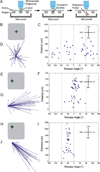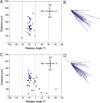Laser-based directed release of array elements for efficient collection into targeted microwells
- PMID: 23223411
- PMCID: PMC3558317
- DOI: 10.1039/c2an36342a
Laser-based directed release of array elements for efficient collection into targeted microwells
Abstract
A cell separation strategy capable of the systematic isolation and collection of moderate to large numbers (25-400) of single cells into a targeted microwell is demonstrated. An array of microfabricated, releasable, transparent micron-scale pedestals termed pallets and an array of microwells in poly(dimethylsiloxane) (PDMS) were mated to enable selective release and retrieval of individual cells. Cells cultured on a pallet array mounted on a custom designed stage permitted the array to be positioned independently of the microwell locations. Individual pallets containing cells were detached in a targeted fashion using a pulsed Nd:YAG laser. The location of the laser focal point was optimized to transfer individual pallets to designated microwells. In a large-scale sort (n = 401), the accuracy, defined as placing a pallet in the intended well, was 94% and the collection efficiency was 100%. Multiple pallets were observed in only 4% of the targeted wells. In cell sorting experiments, the technique provided a yield and purity of target cells identified by their fluorescence signature of 91% and 93%, respectively. Cell viability based on single-cell cloning efficiency at 72 h post collection was 77%.
Figures






Similar articles
-
Micropallet arrays for the separation of single, adherent cells.Anal Chem. 2007 Jan 15;79(2):682-7. doi: 10.1021/ac0615706. Anal Chem. 2007. PMID: 17222037
-
Characterization of the laser-based release of micropallets from arrays.J Biomed Opt. 2008 May-Jun;13(3):034007. doi: 10.1117/1.2937475. J Biomed Opt. 2008. PMID: 18601552 Free PMC article.
-
Micropallet arrays with poly(ethylene glycol) walls.Lab Chip. 2008 May;8(5):734-40. doi: 10.1039/b800286j. Epub 2008 Apr 4. Lab Chip. 2008. PMID: 18432343 Free PMC article.
-
Broadening cell selection criteria with micropallet arrays of adherent cells.Cytometry A. 2007 Oct;71(10):866-74. doi: 10.1002/cyto.a.20424. Cytometry A. 2007. PMID: 17559133
-
Large area magnetic micropallet arrays for cell colony sorting.Lab Chip. 2016 Jan 7;16(1):172-81. doi: 10.1039/c5lc01131k. Lab Chip. 2016. PMID: 26606460 Free PMC article.
Cited by
-
A robotic multidimensional directed evolution approach applied to fluorescent voltage reporters.Nat Chem Biol. 2018 Apr;14(4):352-360. doi: 10.1038/s41589-018-0004-9. Epub 2018 Feb 26. Nat Chem Biol. 2018. PMID: 29483642 Free PMC article.
References
-
- Davis JE, Eberwine JH, Hinkle DA, Marciano PG, Meaney DF, McIntosh TK. Neurochem. Res. 2004;29:1113–1121. - PubMed
-
- Dovichi NJ, Hu S. Curr. Opin. Chem. Biol. 2003;7:603–608. - PubMed
-
- Lefievre L, Barratt CL, Harper CV, Conner SJ, Flesch FM, Deeks E, Moseley FL, Pixton KL, Brewis IA, Publicover SJ. Serono. Sym. 2003;7:419–427. - PubMed
-
- Li H, Sims CE, Kaluzova M, Stanbridge EJ, Allbritton NL. Biochemistry-U.S. 2004;43:1599–1608. - PubMed
Publication types
MeSH terms
Substances
Grants and funding
LinkOut - more resources
Full Text Sources
Other Literature Sources

